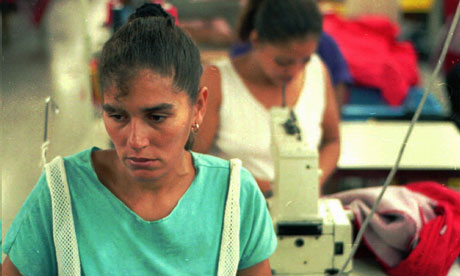While reading, Kawamura's "Japanese Teens as Producers of Street Fashion," I found the section about gothic lolitas kind of relatable. I must admit, I went through a gothic lolita phase for a bit. It started in middle school when I was exposed to Japanese Rock. Even though I was really into gothic lolita, I actually started to wear it in my second year of college. My friend helped me make my outfit and I wore gothic lolita for the first time.

[photo: Christian W.
model: Hope N.]
Before I started to wear lolita, I wanted to make sure I was doing the right thing. I went through LiveJournal communities (forum-like blog communities) about gothic lolita to confirm my outfit before wearing it. A LOT of American girls would refer to internet communities for lolita fashion help. I even looked through all the lolita styles available- carefully deciding which one I'd like to wear. I think I was going through the process Kawamura talked about concerning website communities, rules and topics about the fashion. Due to these websites, I was even aware of some of the brands available for lolita fashion. The communities were harsh as well- you couldn't just wear anything and say it was lolita. One website I found to be very helpful was LolitaFashion.org. According to the website, my outfit may be considered as gothic or kuro lolita. In the communities, there were many times where a girl would post pictures of herself wearing a black puffy dress and claim she was wearing lolita, but many users would flame her and criticize her outfit. Official lolita brands would be a big deal, for many girls would search for deals on Japan Yahoo! Auctions or even sell their used items through the community.
Many of these lolita girls would wear their outfits at lolita meet-ups and especially at anime conventions. It's amazing to see how much lolita fashion has impacted in America. For example, Lady Gaga and Lil' Mama wore lolita a few times.

Lady Gaga in Shiroi Lolita
[image source: http://www.entertainmentwise.com/news/48809/lady-gaga-sends-japanese-fans-wild-with-donut-haircut--pictures ]

Lil' Mama in Sweet Lolita...
[image source: http://abc-lolita.blogspot.com/2010/08/honey-mv-and-mainstream-lolita-in.html ]
Also, in the recent movie Scott Pilgrim Vs. The World, a character is seen wearing gothic lolita.

Gothic Lolita...
[image source: http://www.flickr.com/photos/radiomaru/4885762601/in/set-72157624653630900/ ]
Thankfully, my gothic lolita phase died out quickly since I don't want to spend so much on official lolita brands. However, it was a very fun experience even though my outfit wasn't official, but the style was correct. It makes me wonder if a street fashion would ever develop in America and become such a craze within a community...
[Compact Challenge update]
In my last blog post, I stated that I failed and bought a shirt... Ever since then, I haven't bought anything materialistic...
- Hope (Hyeon) Nam
[inside source: Yuniya Kawamura. "Japanese Teens as Producers of Street Fashion." Reader.]
[outside sources:
http://www.lolitafashion.org/
http://www.entertainmentwise.com/news/48809/lady-gaga-sends-japanese-fans-wild-with-donut-haircut--pictures
http://abc-lolita.blogspot.com/2010/08/honey-mv-and-mainstream-lolita-in.html
http://www.flickr.com/photos/radiomaru/4885762601/in/set-72157624653630900/]




























